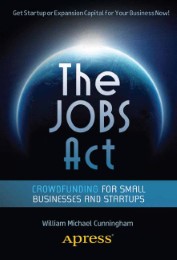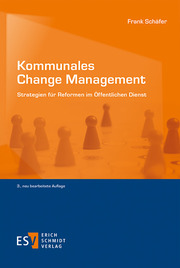The JOBS Act (E-Book, PDF)
The JOBS Act
eBook - Crowdfunding for Small Businesses and Startups
Bibliographische Informationen
Format: Digitale Rechteverwaltung: Digitales Wasserzeichen
Beschreibung
Heres the good news: Small businesses and startups will be able to raise up to $1 million in equity (or debt) funding online via what are calledCrowdfunding Platformsonline communities and websites. Imagine an eBay-like site that allows you to post your idea for a commercial venture online and then allows investors to purchase equity shares or stakes in it. As one journalist put it, its social media meets venture capital.
How can you get in on the new funding opportunities? Thats whatThe JOBS Act: Crowdfunding for Small Businesses and Startups is all about. Investment expert William
Michael Cunningham shows how the new law will enable you to use the internet to raise significant amounts of capital funding for your startup. After discussing briefly the development and implementation of the law, what it means, and how it will impact the business startup marketplace, he delivers the nuts and bolts of how to take advantage of the JOBS Act to access new sources of capital for your small business or startup. As youll see, the act has the power to unleash a new wave of innovation, increase employment, and set many more average entrepreneurs and investors on the road to wealth.
Not just for entrepreneurs,The JOBS Act: Crowdfunding for Small Businesses and Startups will benefit investors, securities lawyers, community development specialists, educators, venture capitalists, and those offering services in the new crowdfunding arena. It is, simply, the most current and most comprehensive compendium of information on the law and its impact on this new market.
Autorenportrait
Inhalt
Part I: Summary of the JOBS ActPart I covers the basic thrust of the law and what it hopes to accomplish.
Chapter 1: The Act: Summary and Definitions
The law targets emerging growth companies and defines them as an issuer with total annual gross revenues of less than $1 billion during its most recently completed fiscal year. These firms are now exempt from certain reporting requirements.To understand the law, you must know the precise meaning of several terms, including Emerging Growth Company and Crowdfunding. In addition, its important to understand the set of institutional arrangements that govern the market for startup financing. Using examples, charts, and graphs, I will describe the marketplace.
Chapter 2: The Startup Financing Environment: Why Now?
Using information on startup business capital flows, I will describe how startups are currently financed. The impact of the financial crisis on the availability of capital for startup business financing will be described in detail.
Part II: DisclosureOne of the major changes promulgated by the JOBS Act is the change on financial disclosures. Startups are relieved from many of the more burdensome accounting and reporting requirements, especially requirements that are imposed by the Securities and Exchange Acts of 1933 and 1934. This section will describe these changes in detail, and provide sample before-and-after financial statements.
Chapter 3: Emerging Growth Companies
Emerging Growth Companies are defined as firms with less than $1 billion in revenue. This is a large and amorphous grouping. I will present charts and graphs showing the number and type of firms in this category. In addition, I will describe characteristics of companies in this group and how they might take advantage of the new law.
Chapter 4: Accounting and Other StandardsAccounting and other information standards and regulations have been significantly reduced for Emerging Growth Companies. This chapter will enumerate those changes.
Chapter 5: CrowdfundingCrowdfunding can be described as social mediaenabled business financing. Startups and others use crowd financing to raise capital for business ventures. Startups, special ventures, and small- and medium-sized businesses can all use crowdfunding. This chapter outlines the short history of crowdfunding and the huge impact the law will have.
Chapter 6: Funding PortalsA Funding Portal is, according to the law, any person acting as an intermediary in a transaction involving the offer and sale of securities for the account of others, solely pursuant to section 4(6) of the Securities Act of 1933 (15 U.S.C. 77(d)(6)). In plain English, it is a website that facilitates the creation and sale of equity (or debt) securities issued by startups. If eBay, for example, were to allow people on their site to sell shares of stock in new ventures, it would be a Funding Portal. This chapter will detail how portals operate and what it takes to become one.
Part III: The Act, by TitleIn the final third of the book, I offer verbatim language of the JOBS Act, along with my commentary on each section. This will be important, as sometimes citizens can "set the rules" and influence the practical ways the law can be applied before regulators start codifying it.
Chapter 7: Title I Reopening American Capital Markets to Emerging Growth CompaniesCommentary
Chapter 8: Title II Access to Capital for Job CreatorsCommentary
Chapter 9: Title III - CrowdfundingCommentary
Chapter 10: Title IV Small Company Capital FormationCommentary
Chapter 11: Title V - Private Company Flexibility and GrowthCommentary
Chapter 12: Title VI Capital ExpansionCommentary
Chapter 13: Title VII - OutreachCommentary
AppendixCrowdfunding sites
E-Book Informationen
„eBooks“ sind digitale Bücher. Um eBooks lesen zu können, wird entweder eine spezielle Software für Computer, Tablets und Smartphones oder ein eBook-Reader benötigt. Da es eBooks in unterschieldichen Formaten gibt, gilt es, folgendes zu beachten.
Von uns werden digitale Bücher in drei Formaten ausgeliefert. Die Formate sind EPUB mit DRM (Digital Rights Management), EPUB ohne DRM und PDF. Bei den Formaten PDF und EPUB ohne DRM müssen Sie lediglich prüfen, ob Ihr eBook-Reader kompatibel ist. Wenn ein Format mit DRM genutzt wird, besteht zusätzlich die Notwendigkeit, dass Sie einen kostenlosen Adobe® Digital Editions Account besitzen. Wenn Sie ein eBook, das Adobe® Digital Editions benötigt, herunterladen, erhalten Sie eine ASCM-Datei, die zu Digital Editions hinzugefügt und mit Ihrem Account verknüpft werden muss. Einige eBook-Reader (zum Beispiel PocketBook Touch) unterstützen auch das direkte Eingeben der Login-Daten des Adobe Accounts – somit können diese ASCM-Dateien direkt auf das betreffende Gerät kopiert werden.
Da eBooks nur für eine begrenzte Zeit – in der Regel 6 Monate – herunterladbar sind, sollten Sie stets eine Sicherheitskopie auf einem Dauerspeicher (Festplatte, USB-Stick oder CD) anlegen. Außerdem ist die Anzahl der Downloads auf maximal 5 begrenzt.
Weitere Artikel aus der Kategorie "Wirtschaft/Management"
Lieferbar innerhalb 24 Stunden

Neuerscheinung

Neuerscheinung

Vergriffen







